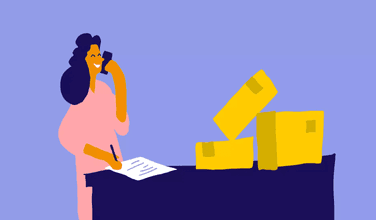How To Upsell to Your Ecommerce Customers
We are inundated daily with countless ads throughout our day, both online and offline. As an ecommerce store retailer, one of the challenges that you may face is trying to get your products and message across to prospective customers.
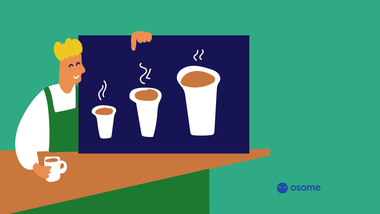
We are inundated daily with countless ads throughout our day, both online and offline. As an ecommerce store retailer, one of the challenges that you may face is trying to get your products and message across to prospective customers. Upselling and cross-selling are ecommerce marketing strategies that you could use to make your products stand out.
By the way, keep in mind that after applying these strategies, your business might grow and there might be more transactions happening on your ecommerce store. Be sure to find an accountant who understands the ecommerce business then!
Definition of Upselling and Cross-Selling
Upselling is an ecommerce strategy that means selling or offering a more premium product or upgraded service than the one your customer is considering. For example, if someone wants to purchase a $1,649 128GB iPhone 13 Pro, you can offer to her the $2,629 1TB iPhone 13 Pro Max. Upselling targets customers who are willing to fork out more money for a better version of a product.
Cross-selling is recommending items complementary to the items a buyer has added to his cart. For example, if a customer adds washing-up liquid to his cart, you can propose sponges for him to buy. In the ecommerce strategy of cross-selling, the product offered is not an upgrade or add-on to the intended purchase but a useful one when used together with the first product.
Reasons for Upselling and Cross-Selling
A part of an ecommerce’s business strategy, the upselling and cross-selling marketing strategies anticipate a customer’s wants and needs. Upselling gives customers a wider range of options, and cross-selling recommends useful products to meet the customer’s needs.
Examples of these ecommerce strategies in an online store include:
- Recommending batteries to the customers when they browse for battery-operated toys.
- Displaying more superior run times and “latest technology” tags for the more premium range of cordless stick vacuums.
It's a win-win situation for both ecommerce stores and their customers. These are the benefits of upselling and cross-selling for the ecommerce store:
Increases Customer Retention
It costs much less to retain customers than to acquire new ones. Wix reported that stores that showcase related items on the same page of their products achieved an average of 43% more sales. Upselling and cross-selling are effective ecommerce marketing strategies that add value to a customer’s shopping experience. When the customer’s problems are solved through buying the complementary or upgraded version of items that they intended to buy, their expectations are exceeded, and they would be more likely to continue patronising the ecommerce store.
Increases Average Order Value and Life-Time Value
Naturally, upselling and cross-selling increases the average order value of your store. Profit and revenue are maximised while minimising the initial customer acquisition costs, which boosts your ROI and lifetime value. Marketing Metric reported that it is 60-70% more likely to sell to an existing customer rather than a new prospect (only 5-20%).
Product Promotion
Upselling and cross-selling are ecommerce business strategies that introduce your customers to a wider range of your products, at a wider range of price points. Offer products tailored to your customers’ buying trends (via Google Analytics) though, for a more targeted approach.
Which Products To Upsell and Cross-Sell?
To decide which products to upsell and cross-sell, look at your ecommerce store’s metrics and sales numbers. Upsell and cross-sell products that you identify as having consistently high sales, products that go well together, and also products that are trending. Keep the weather and yearly celebrations in mind too as you could employ the upselling and cross-selling ecommerce digital marketing plans according to the season. For example, upsell cashmere over woolen coats for winter; cross-sell sunglasses with sunscreen cream during summer.
Strategies for Upselling and Cross-Selling:
We have covered the ‘what’, ‘why’, and ‘who’ of upselling and cross-selling. Now let us get to the most interesting bit: the ‘how’! There are many ways to suggest more products to your prospective customers without being too ‘pushy’ and we have listed some of them below:
Product Bundling
Product bundling means selling items that are complementary to each other together. For example, selling kitchen cabinets with a sink, cooker hob and hood, and oven. The ecommerce bundling technique strategy would be more attractive if the bundle is priced lower than buying the products individually and/or with a flat-shipping rate when bought together.
There are several ways to integrate this product bundling technique into your online store to recommend complementary items to your customers. They include displaying products on your ecommerce store under the headings such as “frequently bought together”,“you might also like”, and “people also viewed”.
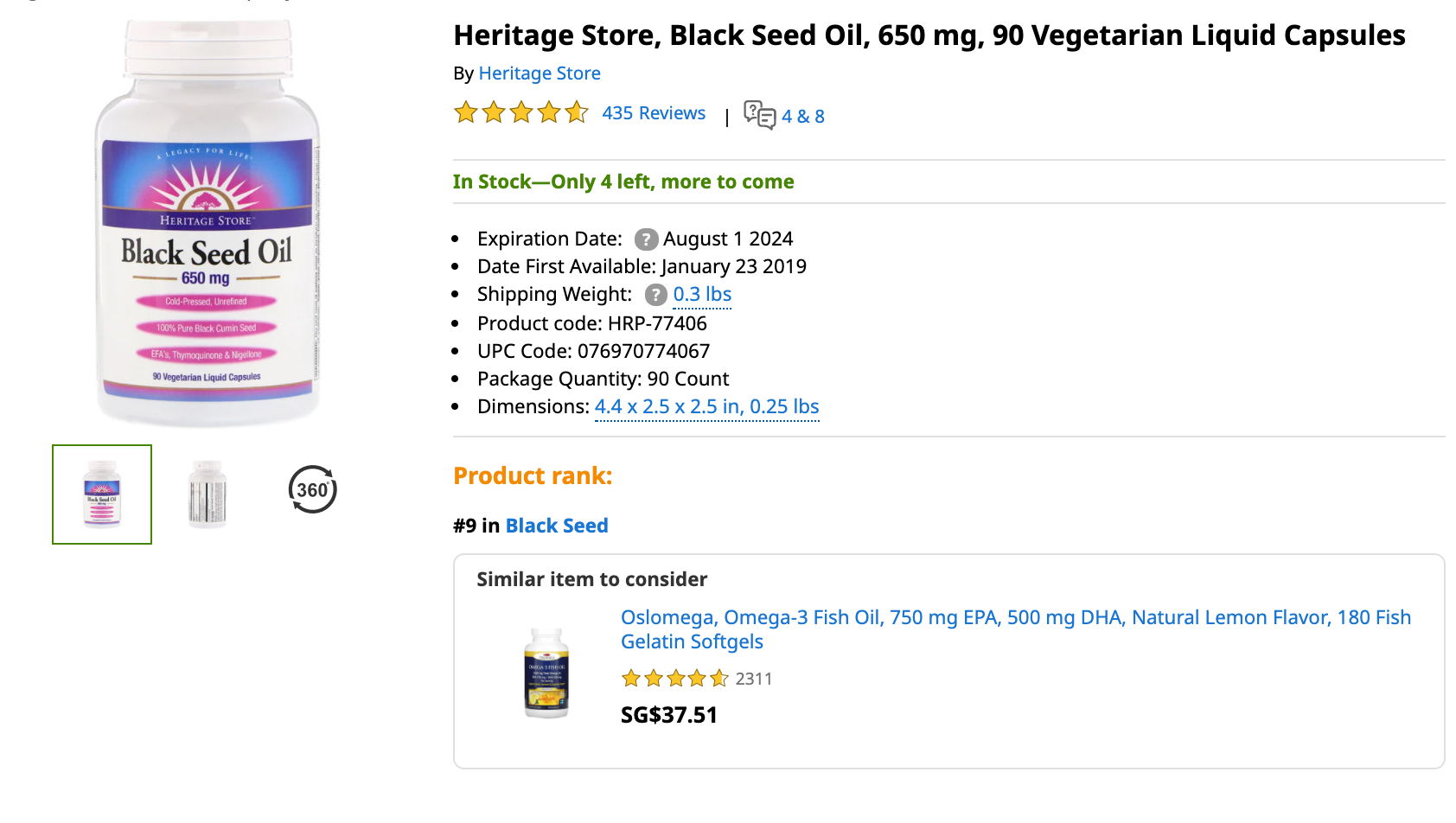
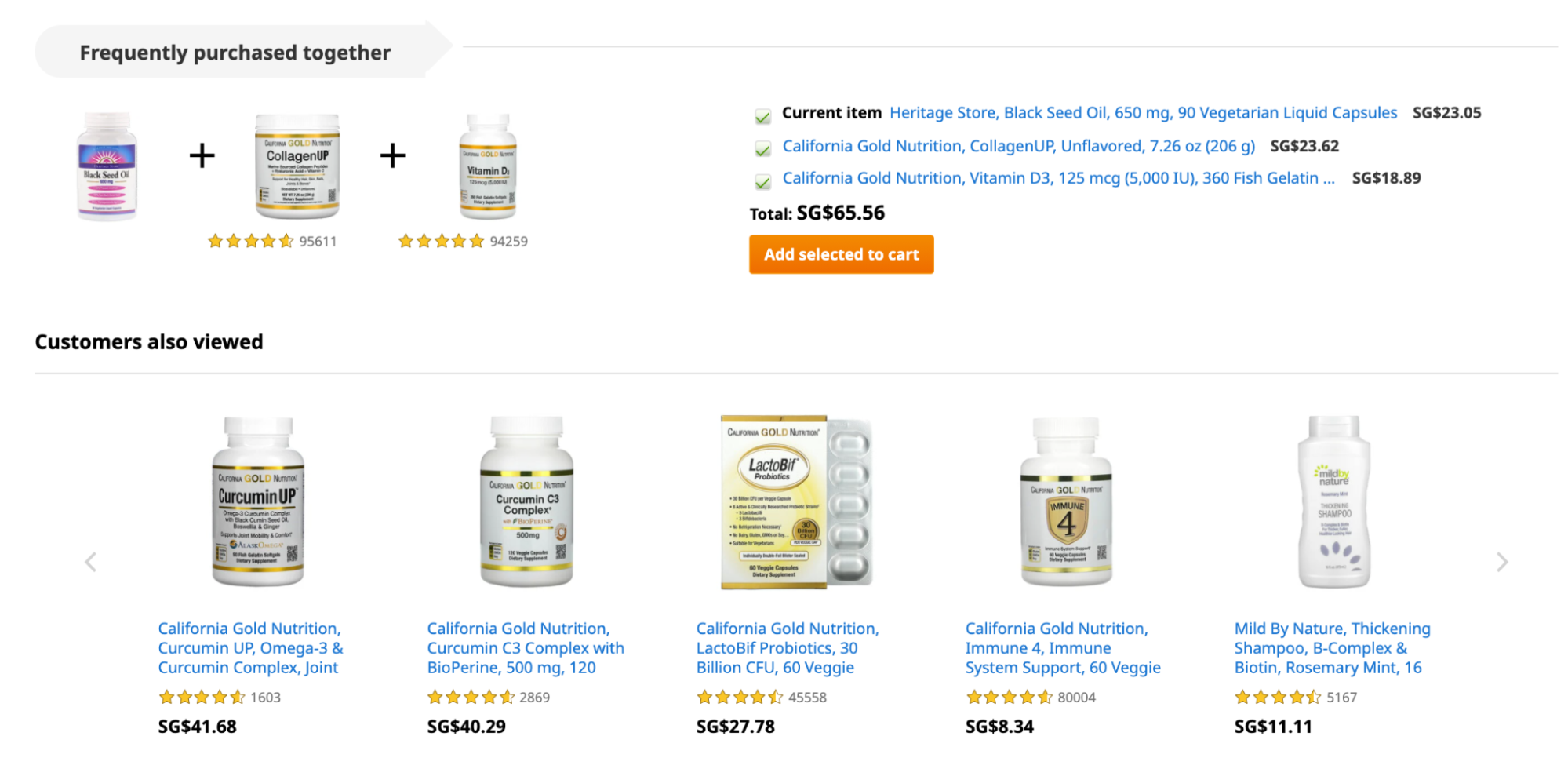
Here, the online health products store iHerb.com employed a combination of these phrases for its product bundling ecommerce strategy. When clicking on a product recommendation for “Black Seed Oil”, they proposed a “similar item to consider”, products “frequently purchased together”, and products “customers also viewed”.
“Shop the Look”
Most commonly employed for fashion and lifestyle products, this ecommerce strategy is suitable for product launches too. On an online store, the ‘shop the look’ bundling method is presented using high-resolution images of many related products, usually in a studio setting, and with price tags and product links and descriptions for the featured products. You could also increase your average order value by offering free delivery for orders that exceed a certain minimum order value. Ikea Spain uses this ecommerce strategy as shown below, where shoppers could add-to-cart the highlighted products easily.

Narrowing Choices
You would think that presenting as many options as possible when upselling would improve the conversion rates -sometimes it will, but other times, narrowing down the choices makes more sense. In the 1995 “famous jam study” of choice conducted by Columbia University revealed that offering 6 jams, compared to 24 jams, resulted in 30% of sales of those who sampled at the 6 jams booth, compared to only 3% for the other booth. You could do an A/B test on your website to find out if your prospects prefer being presented with many or less options. Upselling and cross-selling is not a hard-selling tactic. Instead, it empowers your customers to make a more informed and well-rounded choice when buying.
Dummy Choices

From GoDaddy’s website builder pricing plans, we could see that the Standard plan of SGD $11.99 is the dummy choice. A dummy choice is a choice whose price is the anchor or referral point; one that the retailer is not exactly trying to sell. The retailer would actually be pushing the next higher priced items. In this example, the website builder is trying to sell its Premium plan rather than its Standard, making it just slightly more expensive than the Standard plan. Providing a dummy choice is a great upselling method because giving just two choices might sometimes result in the customer choosing the cheapest option, as demonstrated by the Economist subscription ad study.
Seasonal, Limited Edition Collections
Cross-sell products according to the weather and season. If possible, set regional campaigns on your websites. This is because, if you are running a global ecommerce business, there would be different weather conditions within the same big country (e.g. cold up north but warm down south). During the rainy season for example, you could cross-sell umbrellas, boots, raincoats and other waterproof gear.
Proposing limited edited collections creates urgency which increases the value of the upsell. Include a countdown ticker if you have limited quantities and a short offer period for your limited edition items.
Premium Add-Ons and Services
Installation and delivery services, warranties and samples are all add-ons and extra services that you could offer as your upselling ecommerce promotion strategy. Free samples of higher-end or luxury items could help customers discover new brands and they might swap their usual brands for the upsell on their next purchases. The add-ons and optional services are usually at the checkout page, but you could also display them at the product page, as Wayfair did below. For its “Lattimer 4-in-1 Convertible Crib” product listing, Wayfair offers assembly services and a 5-year protection plan as add-ons.
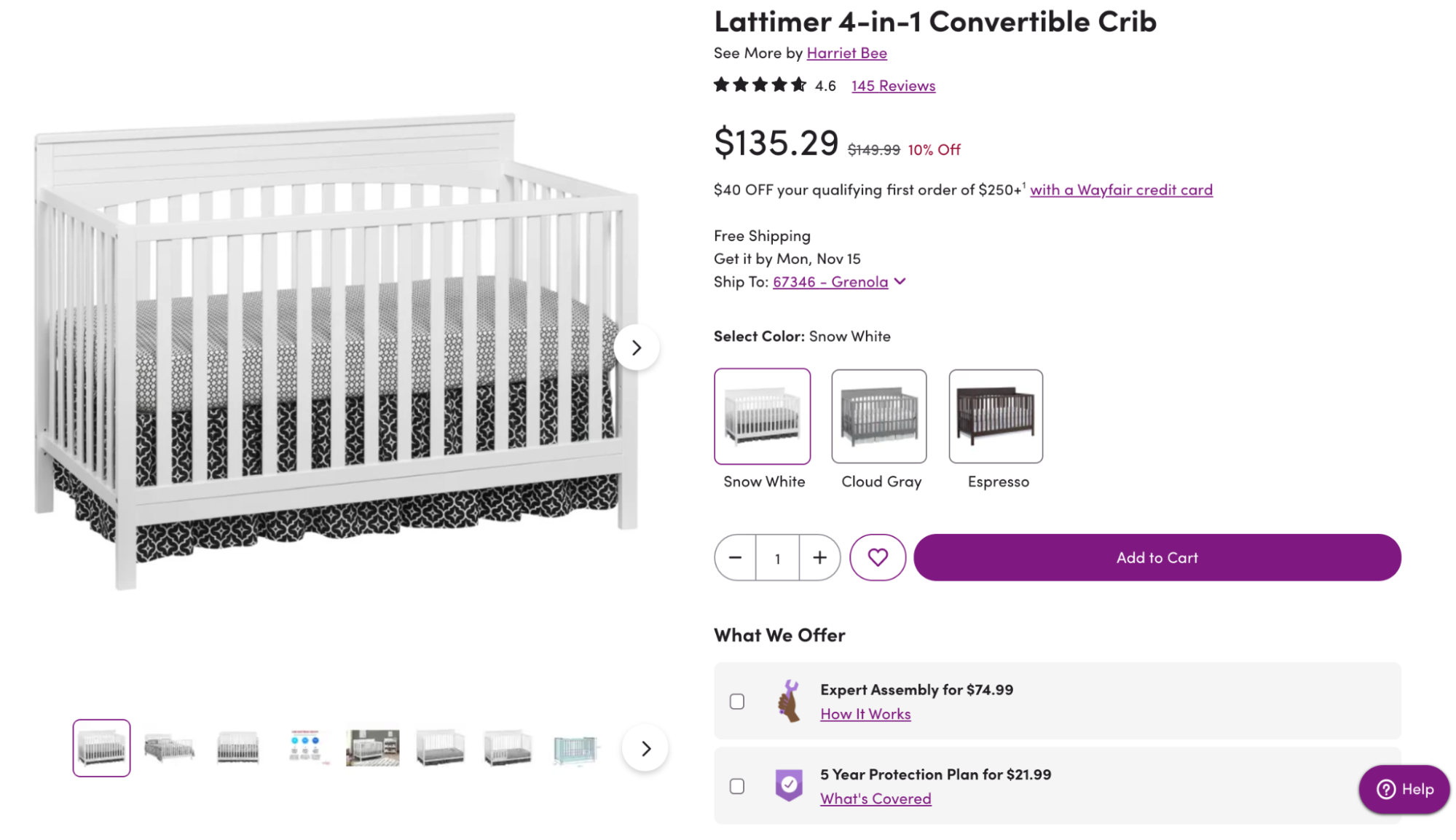
Customer Reviews
Online reviews and customer engagements are the online equivalents of word-of-mouth referrals. The Consumer Content Report: Influence in the Digital Age report by Stackla found that user generated content is the most authentic and influential content. Developing trust and building rapport among your customers is important for your brand -it will help build customer loyalty.
When recommended by their friends and family, customers are willing to go for more expensive, premium products and bundles. While as an ecommerce store you may not be able to always feature their friends or family, showing many positive reviews would increase customers’ confidence when making a purchase, and increase the likelihood of an upsell and cross-sell. You can make it convenient for your customers to share reviews by creating a QR Code for Google reviews and placing them on your product's packaging.
Trust Signals
Display social proof statistics such as quantity of available products, number of products sold, and number of users, as they emit trust signals to prospective buyers. Doing this would establish you as an authority in your industry.
Upselling and Cross-Selling Channels
To get the most out of upselling and cross-selling, integrate these effective ecommerce marketing strategies into all of your store platforms, both on-site and off-site channels.
On-Site Upselling and Cross-Selling Channels
On-site channels are on the ecommerce store's own website or ecommerce platforms. Upsell and cross-sell on your:
- Homepage: Akin to the window display of a physical store, your ecommerce store’s landing page is your prospects’ first touchpoint to your brand. Lead them to your latest offers and promotions, and showcase your top-selling and most recommended products. It is never too early to start upselling and cross-selling.
- Product Pages: Suggest product bundling offers and complementary products to customers who have already shown their interest in your product.
- Shopping Cart: As your customers are making an exit from your ecommerce store, grab their attention by presenting them with the online version of the impulse display shelf before checkout: irresistible deals of cross-sells and upsells.
Off-Site Upselling and Cross-Selling Channels
The global average conversion rate across all ecommerce markets was 1.79% in September 2021. Therefore, do not fret if website visitors leave without making a purchase. Maximise your reach with off-site upselling and cross-selling channels:
- Instagram: With shoppable Instagram content and the Shop tab, convert views into purchases with in-app shopping on Instagram. Remember, high-quality images and thoughtful captions go a long way!
- Facebook: Facebook’s dynamic ads have specific cross-selling and upselling targeting options that you could use.
- Email: Emails are a great way to remind customers about the items left in their shopping carts (especially if you are offering discounts on those items). Sending regular newsletters shows that you care about them, and you can keep your customers in the loop when you have new products or exclusive offers. Don't forget to use DKIM for boosting email deliverability and message alteration. What is DKIM? DKIM is the second level of protection when transferring data between mail servers ,a mechanism that works through encryption keys.
Upselling and Cross-Selling Post-Purchase
Your upselling and cross-selling ecommerce business strategies does not need to end upon checkout. You can continue recommending them products you consider useful via these methods:
- Recommend products which are related to the products your customers have purchased, rather than random products. This could be done by abandoned cart emails and remarketing.
- Next-purchase coupons and discounts entice customers to return and spend (again) in your online store.
- Giving a free gift if a customer chooses the upsell encourages them to recommend your ecommerce store to others, or return to your store for their next purchase.
- Free samples would expose or convert buyers to a wider (and perhaps more expensive) range of a brand’s products.
Your customers would definitely appreciate a well-presented upsell and cross-sell; never be too pushy. For seamless accounting and reporting for your ecommerce store, check out our affordable accounting services for businesses in Singapore that would run efficiently in the background while you focus on growing your company.





